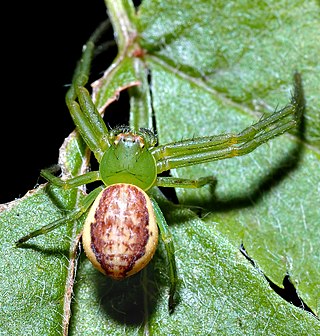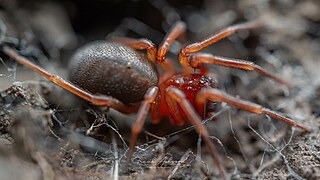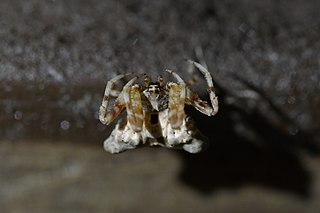
Celaenia excavata, the bird dropping spider of Australia and New Zealand, derives its name from mimicking bird droppings to avoid predators, mainly birds.

Diaea is a genus of crab spiders first described by Tamerlan Thorell in 1869. Most species are found in specific locations except for D. livens, which occurs in the United States and D. dorsata, which has a palearctic distribution. Adults are 5 millimetres (0.20 in) to 7 millimetres (0.28 in) and tend to hide in and around vegetation, especially flowers, where their color allows them to blend in to their surroundings.

Dolomedes minor is a spider in the family Pisauridae that is endemic to New Zealand, where it is known as the nursery web spider.

Hexathele hochstetteri, commonly known as the banded tunnelweb spider, is a spider in the family Hexathelidae, found only in New Zealand. It is common on the North Island, and uncommon on the South Island.

Trite auricoma, commonly known as the golden-brown jumping spider, is a species of jumping spider endemic to New Zealand.
Laetesia trispathulata is a species of sheet weaver spider found in New Zealand.

Nanometa purpurapunctata is a species of spider in the family Tetragnathidae. It is found in New Zealand.

Periegops suterii is a species of spider in the genus Periegops that is endemic to the South Island of New Zealand.

Backobourkia brouni,, or Broun's marbled orb-weaver, also often referred to by its synonym Backobourkia brounii, is a spider native to Australia and New Zealand.

Sidymella angularis, is a species of crab spider endemic to New Zealand.

Celaenia olivacea is a species of Araneidae spider that is native to New Zealand.

Colaranea viriditas is a species of orb-weaver spider that is endemic to New Zealand.

Cyclosa trilobata is a species of orb-weaver spider that is native to New Zealand and Australia.
Tetragnatha flavida is a species of Tetragnathidae spider that is endemic to New Zealand.

Laperousea blattifera is a species of sheet weaver spider found in New Zealand and Australia.
Haplinis diloris is a species of sheet weaver spider endemic to New Zealand.
Haplinis fucatinia is a species of sheet weaver spider endemic to New Zealand.
Haplinis mundenia is a species of sheet weaver spider endemic to New Zealand.
Haplinis rufocephala is a species of sheet weaver spider endemic to New Zealand.
Theridion ampliatum is a species of Theridiidae that is endemic to New Zealand.














